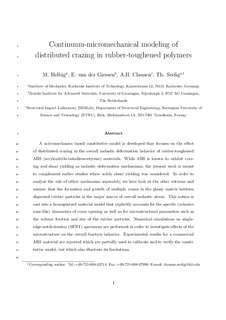| dc.contributor.author | Helbig, Martin | |
| dc.contributor.author | Van Der Giessen, Erik | |
| dc.contributor.author | Clausen, Arild Holm | |
| dc.contributor.author | Seelig, Thomas | |
| dc.date.accessioned | 2017-12-15T15:52:20Z | |
| dc.date.available | 2017-12-15T15:52:20Z | |
| dc.date.created | 2016-03-30T13:06:05Z | |
| dc.date.issued | 2016 | |
| dc.identifier.citation | European journal of mechanics. A, Solids. 2016, 57 108-120. | nb_NO |
| dc.identifier.issn | 0997-7538 | |
| dc.identifier.uri | http://hdl.handle.net/11250/2472255 | |
| dc.description.abstract | A micromechanics based constitutive model is developed that focuses on the effect of distributed crazing in the overall inelastic deformation behavior of rubber-toughened ABS (acrylonitrile-butadiene-styrene) materials. While ABS is known to exhibit crazing and shear yielding as inelastic deformation mechanisms, the present work is meant to complement earlier studies where solely shear yielding was considered. In order to analyze the role of either mechanism separately, we here look at the other extreme and assume that the formation and growth of multiple crazes in the glassy matrix between dispersed rubber particles is the major source of overall inelastic strain. This notion is cast into a homogenized material model that explicitly accounts for the specific (cohesive zone-like) kinematics of craze opening as well as for microstructural parameters such as the volume fraction and size of the rubber particles. Numerical simulations on single-edge-notch-tension (SENT) specimens are performed in order to investigate effects of the microstructure on the overall fracture behavior. Experimental results for a commercial ABS material are reported which are partially used to calibrate and to verify the constitutive model, but which also illustrate its limitations. | nb_NO |
| dc.language.iso | eng | nb_NO |
| dc.publisher | Elsevier | nb_NO |
| dc.rights | Attribution-NonCommercial-NoDerivatives 4.0 Internasjonal | * |
| dc.rights.uri | http://creativecommons.org/licenses/by-nc-nd/4.0/deed.no | * |
| dc.title | Continuum-micromechanical modeling of distributed crazing in rubber-toughened polymers | nb_NO |
| dc.type | Journal article | nb_NO |
| dc.type | Peer reviewed | nb_NO |
| dc.description.version | acceptedVersion | nb_NO |
| dc.source.pagenumber | 108-120 | nb_NO |
| dc.source.volume | 57 | nb_NO |
| dc.source.journal | European journal of mechanics. A, Solids | nb_NO |
| dc.identifier.doi | 10.1016/j.euromechsol.2015.11.007 | |
| dc.identifier.cristin | 1347613 | |
| dc.relation.project | Norges forskningsråd: 237885 | nb_NO |
| dc.description.localcode | Copyright © 2015 Elsevier Masson SAS. All rights reserved. This is the authors' accepted and refereed manuscript to the article, locked until 17 December 2017 due to copyright issues. | nb_NO |
| cristin.unitcode | 194,64,45,0 | |
| cristin.unitname | Institutt for konstruksjonsteknikk | |
| cristin.ispublished | true | |
| cristin.fulltext | postprint | |
| cristin.qualitycode | 1 | |

